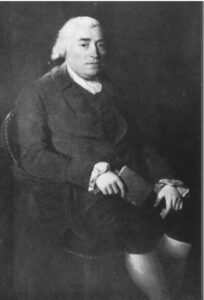
by John Thomson
Present-day controversies on renaming institutions are often about whether we judge the worth of our historical figures by the singular issue of slave-owning.
One particular controversy needs a referee to call a foul: over a historian’s error in a biography of the English lord, Thomas Fairfax, 6th Lord Fairfax of Cameron (1693-1781).
Fairfax lived at Greenway Court, one mile from White Post, Virginia. He had moved from England to manage 5 million acres of an inherited land grant. He resided here, became a part of local history, and was buried in Winchester.
Several decades after the biography was published, the error was unearthed and recently used to justify effacing his name from the local 50-year-old Lord Fairfax Community College (LFCC).
The error has also been used as a cause to rename Fairfax county, and as a political bludgeon against the current holder of the Fairfax title, the 14th Lord Fairfax of Cameron, who presently sits in the British House of Lords. In her June 14th, 2020, article, “As statues of slave traders are torn down, their heirs sit untouched in the Lords”, Catherine Bennett, a columnist for the British paper, The Observer, wrote the following:
Consider also the 14th Lord Fairfax of Cameron, a Conservative peer, whose slave-trading ancestor, the 6th Lord Fairfax of Cameron, owner of vast plantations in Virginia, reportedly enjoyed what he called “bedding down with a negro wench”. Or, as we would now think of it, rape.
Fairfax may be considered a “Founding Grandfather.” In his book, “John Marshall: Defender of a Nation” (an excerpt appears here), Jean E. Smith mentions Fairfax’s many influences on young George Washington and on the family of future Chief Justice John Marshall. Smith wrote that Fairfax’s wilderness home and personal library were “an exceptional frontier oasis of learning and culture.”
Regardless of the admiration Fairfax had among the people of his day, a reputation cannot survive against an accusation of being a mass rapist of black slaves.
Taken from the renaming information webpage of LFCC: “There are historical
records indicating Lord Fairfax engaged in long-term sexual abuse of enslaved women”.
However, there is no evidence he raped any slaves or otherwise sexually
abused them.
The claim originates from the late Stewart E. Brown, Jr.’s biography on
Fairfax, Virginia Baron, published in 1965, a book repeatedly referenced
by the school’s renaming committee.
Brown made an egregious error interpreting an old receipt, then compounded the mistake by changing the original text of the receipt and adding flippant speculation. LFCC bundled this as “historical records.”
Brown made a fairly accurate transcription of the receipt, but only in the appendix. The original archived receipt reads as follows: “february the 27th 1777 Receved of Curtis Corley ten shillings on his Lords ship acount, for Bringing a negro wench to Bed. Sary Balengar.” However, elsewhere in his book, Brown changed that to, “bedding down with a negro wench,” a very different meaning.
Either way, though, Brown claimed that this receipt proved Fairfax paid to have sex with a slave. He also speculated it was evidence for a rumor that Fairfax had children by many slaves, and said it proved Fairfax was “virile” at the age of 83; however, Brown gave no evidence for any of his claims.
Yet, the Collins Dictionary says “to be brought to bed” is an old British-English expression meaning “childbirth.” Correctly, The Virginia Historical Society catalogued the receipt, as: “Receipt dated 27 February 1777 issued to Curtis Corley as agent of Thomas, Lord Fairfax, for midwife services provided to a slave woman.”
So, Sary Balengar was by no means a provider of sexual partners for the eighty-some year old English nobleman but was, rather, a midwife who earned wages for her medical expertise.
This erroneous claim was often mentioned directly and indirectly in the LFCC Sept. 02, 2020 college naming workgroup meeting, and was used to berate Fairfax. The minutes are found here:
One member of the renaming committee said Fairfax “partook in a pay-for-rape scenario” and “viewed the act as a business transaction.”
Many of the comments (but not all) about Lord Fairfax were misinformed and not historically accurate. Commenters were not personally identified in the minutes.
Brown’s error evaded this collection of PhDs, LFCC administrators, historians, and a Warrenton, Virginia town councilman.
The error might evade anyone not well-read in literature from Colonial or Victorian eras, or not sufficiently curious to sleuth the world-wide-web for information about Fairfax.
After diminishing Fairfax’s historical significance and promoting this inflammatory error on its website, LFCC threw Fairfax in the trash can. A former president of the college wrote that he was a “very minor historical figure.” The president of the college said “the name is just not good enough for us.”
The same day the LFCC proposed its new name, Laurel Ridge Community College, its re-naming information webpage was still claiming that Fairfax sexually abused black slaves.
How many graduates of LFCC want to show a diploma titled with “Lord Fairfax”, where the very school devalued it by claiming Fairfax was a mass rapist of slaves?
To persist in this claim, and for LFCC President Blosser not to issue a public apology, shows a lack of academic integrity and disrespect for the history of our region.
John Thomson resides in Front Royal.

Leave a Reply
You must be logged in to post a comment.